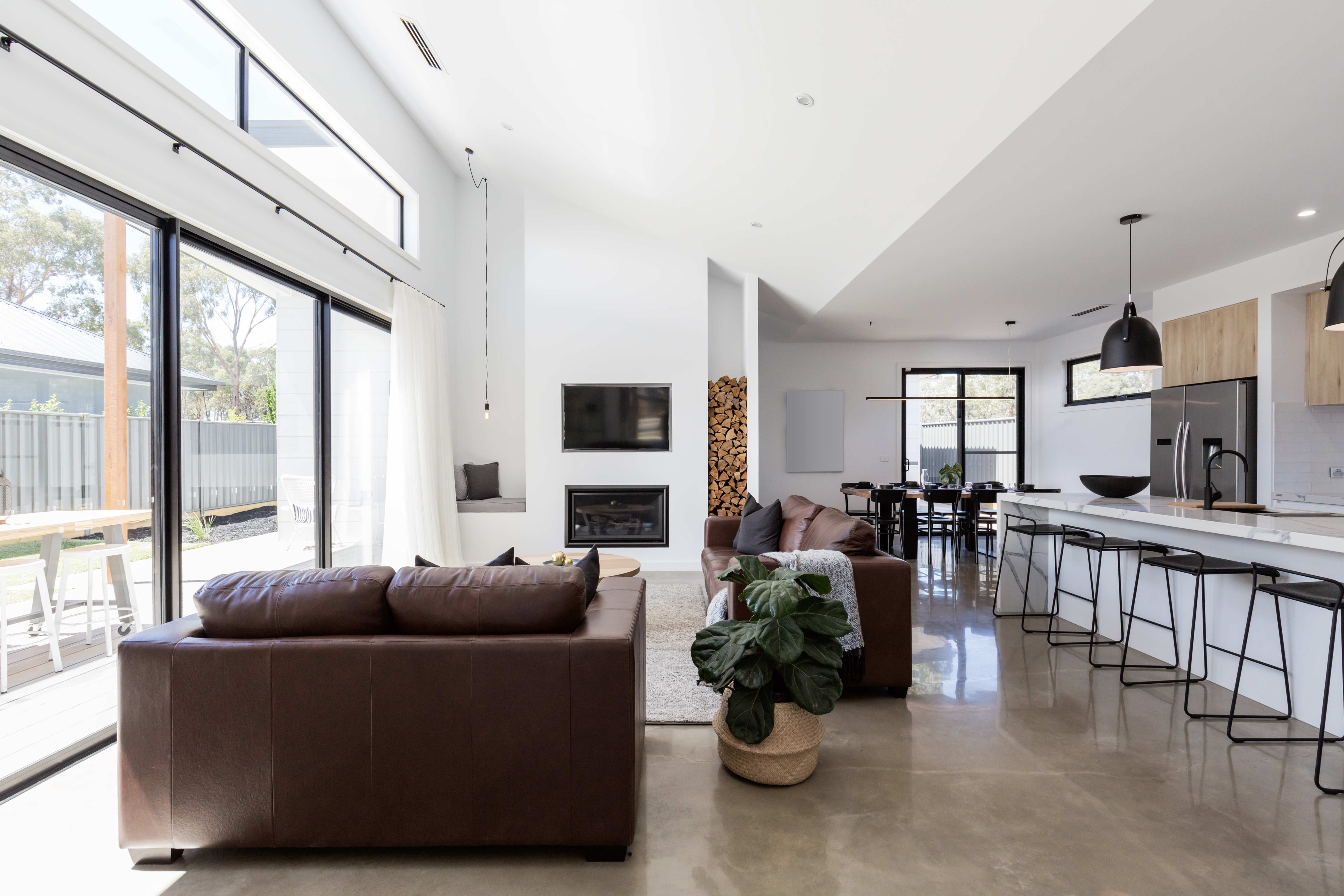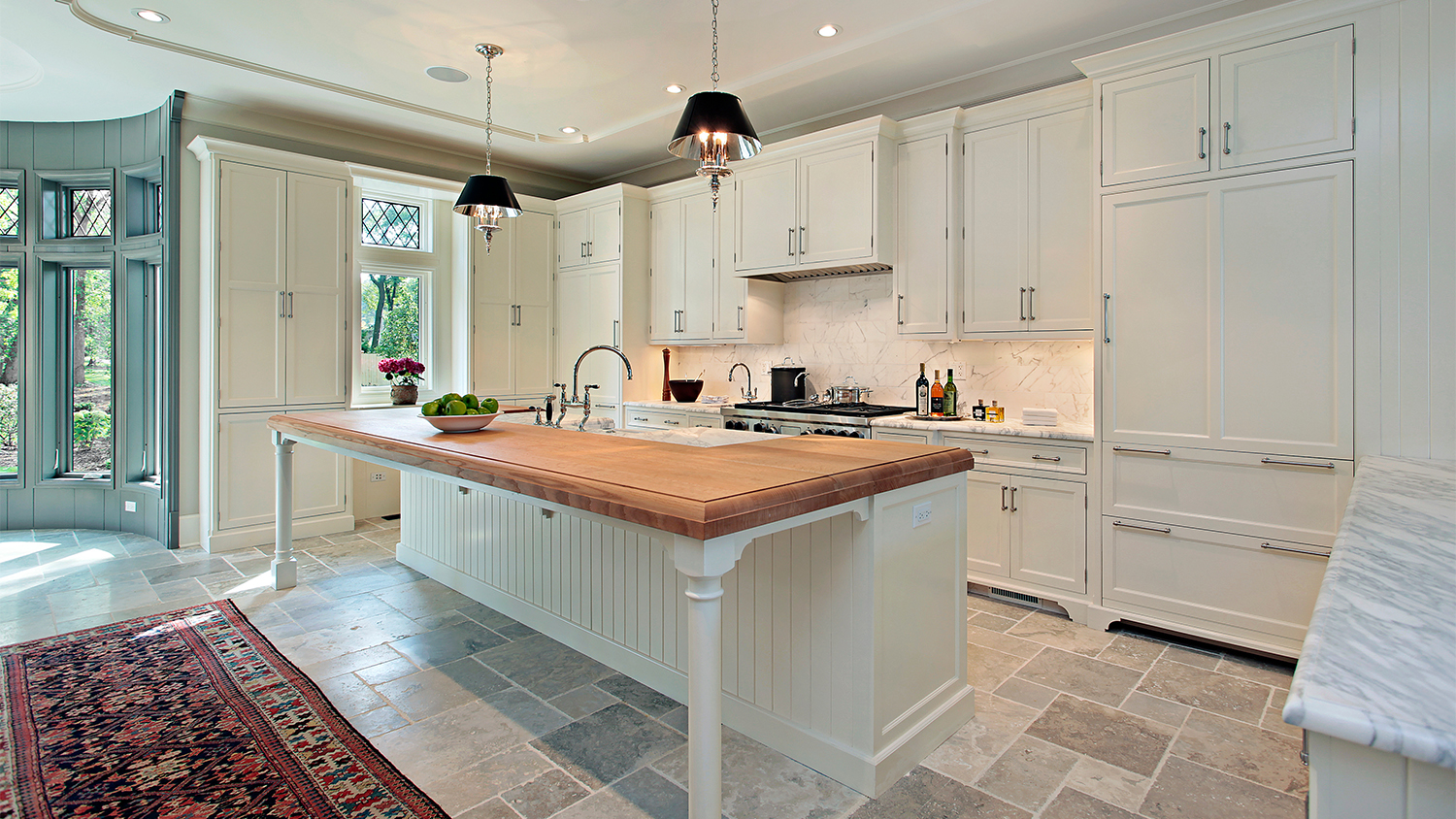
Installing new baseboards can totally refresh the look of your walls. Learn about the cost to install baseboards in your home.
Terrazzo flooring costs $4,400 to install, with prices ranging between $4,000 and $7,000 on average. A pro will determine the final cost based on the type, installation area, and installation method.


Terrazzo flooring costs between $9 and $35 per square foot on average, depending on the type and installation method.
Terrazzo tiles are more affordable at $9 to $22 per square foot installed, and poured terrazzo ranges from $15 to $35 per square foot due to higher labor requirements.
The type of aggregate you choose impacts cost, with glass chips being more affordable than luxury options like marble or Mother-of-Pearl.
Terrazzo floors can last 40 to 100 years with proper maintenance.
The installation process is very advanced—you’ll likely need to use a pro.
Terrazzo flooring costs between $4,000 and $7,000 per square foot on average for its chippy, statement-making aesthetic. Most homeowners end up paying around $4,400, depending on various factors, including whether the terrazzo is made from cement or epoxy. This guide will walk you through the costs and all the different elements that impact its overall installation price tag.

Materials, labor, and terrazzo styles all determine how big or small your final price will be. Here’s a breakdown of what factors influence the cost of this type of cement or epoxy flooring.
Terrazzo flooring costs greatly depend on the size of the area you’re updating. Here are some common room sizes with their average costs.
| Room Size in Feet | Square Footage | Average Cost |
|---|---|---|
| 10x10 | 100 | $900–$3,500 |
| 15x15 | 225 | $2,100–$7,900 |
| 20x20 | 400 | $3,000–$14,000 |
| 25x25 | 625 | $5,600–$21,900 |
Terrazzo is commonly used in applications like schools and municipal buildings. You may find a lower price per square foot for large-scale commercial projects than you would for a smaller residential project.
Terrazzo flooring is made from pieces of aggregate set in a cement or epoxy base. Though price tags are similar for materials, when it comes to flooring installation costs, you’ll find that tile is the most affordable option. This is because it takes less labor to install.
| Type of Terrazzo Floor | Average Cost (Materials Only) | Average Cost (Including Labor) |
|---|---|---|
| Tile | $4–$12 | $9–$22 |
| Poured | $5–$15 | $15–$35 |
Terrazzo tiles cost between $4 and $12 per square foot, with an additional $5 to $10 per square foot for labor. This cost-effective option isn’t as durable as poured terrazzo, but it can cost less than other tiling options, like ceramic tile installation.
Poured terrazzo costs about $5 to $15 per square foot, with an additional $10 to $20 per square foot for labor. This type of terrazzo has a laborious installation process that requires additional steps like pouring the cement or epoxy mixture and polishing the floor. There are three different installation methods.
Depending on your installation method, labor costs $5 to $20 per square foot on top of the cost of materials. If you choose terrazzo tiles, prices are similar to the cost of any other tile installation. Labor costs are higher for poured terrazzo, but the monolithic installation method is generally the most affordable.
| Installation Method | Description | Average Cost per Sq. Ft. |
|---|---|---|
| Thin-set | 1/4–to-3/8-inch layer of epoxy resin; prone to cracks; use indoors only | $40–$60 |
| Sand-cushion | Poured cement base layer with sandy cement mid-layer; aids in expansion/contraction; good for exterior use | $40–$80 |
| Monolithic | Aggregate mixture applied over a concrete subfloor; affordable but prone to cracking if concrete is too moist | $30–$70 |
Terrazzo uses either epoxy or cement as a binder for the pieces of aggregate. Epoxy is typically more affordable at around $25 to $90 per square foot, but it’s not suitable for outdoor applications since it can peel and fade. If you’re installing terrazzo outside, stick with cement despite the higher price tag.
| Epoxy Terrazzo | Cement Terrazzo |
|---|---|
| More affordable | Very durable |
| Simple installation | Versatile |
| Better for indoor use | Great for outdoor use |
| Limited design options | Difficult installation |
Some styles of terrazzo require more labor and materials than others, increasing costs across the board. For example, using divider strips can help you separate each section by color, but you’ll pay more as a result.
Terrazzo comes in several different colors. Black and white are two of the most popular, since they show off the aggregate. Generally, you’ll spend more if you’re mixing aggregates in different colors to create a pattern.

There’s such a large range of terrazzo prices because of the various aggregates you can use. In residential settings, glass and marble are some of the most common, though you’ll also find shells, natural stone, polished metal, Mother-of-Pearl, and recycled materials.
Glass is more affordable than marble. Marble chips cost $25 to $100 for a 50-pound bag. Make sure to also budget for extras like flooring transition strips and new baseboards, if you want to upgrade.
High-end brands like Fritztile and Floorazzo may cost more than terrazzo from other manufacturers. Keep in mind, some brands may have occasional sales on terrazzo tiles, too. You don’t always have to pay full price.
When you’re installing your flooring, you may have some additional costs based on the current state of your home. Here are a few potential costs to keep in mind.
Labor costs for installing epoxy terrazzo also depend on the method of installation. You’ll pay roughly $5 to $20 per square foot of labor for poured terrazzo and an average of less than $10 per square foot of labor for tile terrazzo.
Your contractor will need to remove any furniture in the room before they can install your floors.
For this kind of job, they’ll charge their hourly rate, which is typically between $25 to $35 per hour.
You can install terrazzo over a concrete base, but if you have hardwood flooring or linoleum flooring, you will have to remove your existing floor before you can start your project. It costs around $1 to $2 per square foot to remove old flooring, but removing tile could cost upwards of $7 per square foot.
Typically, you’ll install terrazzo flooring over a concrete subfloor. In some cases, you can also use plywood, especially when reinforced. If you need any repairs to your subfloor, it’s going to cost extra.
| Subfloor Prep or Repairs | Average Cost |
|---|---|
| Subfloor replacement | $3–$10 per square foot |
| Subfloor repair | $400 |
| Subfloor reinforcement | $300–$1,000 |
Terrazzo installation is extremely advanced—even for experienced DIYers. Tiles are typically very large and heavy, while pouring the floor requires a lot of skill (similar to pouring concrete in your yard). You’ll also need to make sure your subfloor is suitable for terrazzo, which requires specific knowledge. Rather than take on this task, hire a flooring company near you.
With a professional job, you’ll pay the added expense of labor. This costs anywhere from $5 per square foot (for tile installation) to $20 per square foot (for poured terrazzo).
Terrazzo flooring has a specific look that homeowners either love or hate. It can certainly add interest to a room, but it’s not right for every home. Before settling on terrazzo, make sure you weigh the pros and cons.
| Pros | Cons |
|---|---|
| Durable and good for outdoors | High initial cost |
| Water-resistant | Cold and hard on bare feet |
| Unique aesthetic | Hard to install |
| Eco-friendly | Could make space look dated |
| Long life span | |
| Low maintenance |
While durable flooring options may cost more, consider the wear and tear your floor will withstand in high-traffic areas, especially in homes with children and pets. If you’d like help choosing a material, a flooring pro can recommend strong materials that will look great in your home.
Terrazzo floors can add value to your home, though, like most flooring upgrades, they often don't recoup their full installation cost. You can expect a return on investment (ROI) of around 55% to 70% when you sell your home.
That said, terrazzo is very durable, lasting 40 to 100 years, which makes it a great choice for homeowners (and buyers) looking for a low-maintenance yet aesthetically pleasing option.
Terrazzo flooring comes with high upfront costs, but there are ways to tighten up your budget. These tips will help you save cash on your project:
Choose an affordable aggregate: Instead of splashing out on a luxury aggregate like mother-of-pearl, go for an affordable option like glass chips or marble chips.
Choose a simple design: The more colors or intricate patterns you involve, the more it will cost. Go for a straightforward, single-color design rather than mixing it up.
Choose terrazzo tile: Tiling isn’t as durable as poured terrazzo, but it’s suitable for indoor applications and often significantly more affordable because of the reduced labor required for installation.
Do some of the work DIY: While installing terrazzo isn’t a suitable DIY project, you can cut down on labor costs by doing the jobs you can handle. Move your own furniture, remove your flooring, and prep the area for installation. When installation is over, clean up the space on your own.
Look for sales: Some retailers may have seasonal sales for terrazzo tiles.
Interview three contractors: Interviewing three contractors can help you better understand the market, figuring out which price is a good value and which might be too good to be true.
Home is the most important place on earth, which is why Angi has helped more than 150 million homeowners transform their houses into homes they adore. To help homeowners with their next project, Angi provides readers with the most accurate cost data and upholds strict editorial standards. We extensively research project costs to develop the pricing data you see, so you can make the best decisions for you and your home. We rely on reputable sources, including the U.S. Bureau of Labor Statistics, academic journals, market studies, and interviews with industry experts—all to ensure our prices reflect real-world projects.
Want to help us improve our cost data? Send us a recent project quote to [email protected]. Quotes and personal information will not be shared publicly.
From average costs to expert advice, get all the answers you need to get your job done.

Installing new baseboards can totally refresh the look of your walls. Learn about the cost to install baseboards in your home.

Linoleum is a popular flooring material because it’s one of the most affordable—but linoleum flooring costs vary from project to project. Let’s break it down.

If your laminate is damaged, it’s time for repairs or replacement. This guide will show you everything you need to know about laminate floor repair costs.

With so many types of polished concrete floors to choose from, you should first learn about the classes of grinding, levels of polishing, and color options.

Baseboards come in many styles and materials, giving your space a finished look. Learn about the types of baseboards, pros and cons, and when to choose each.

Discover limestone flooring costs for your home. Learn about material, labor, and installation factors to plan your flooring project with confidence.